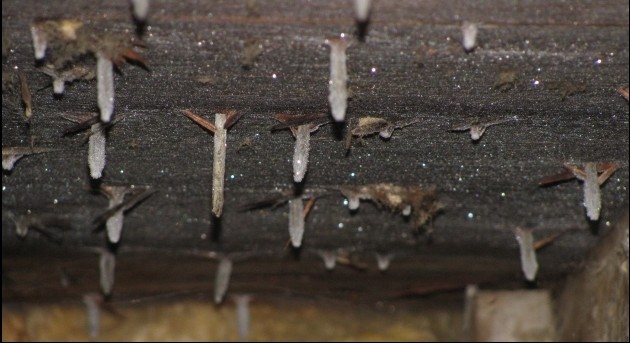Attic Mold Remediation
Simple Strategies For Understanding & Correcting Attic Mold-
Attic mold is extremely common in our Northern climate & Attic Mold growth is generally attributable to 4 basic causes.
1) Lack of adequate ventilation or improper ventilation 2) Existing, past roof, or roof flashing leaks. 3) Improperly exhausted bathroom fans, and or, dryer vents 4) Failure to install enough “Ice Shield Membrane along the eaves.
By far the most common cause of all attic mold is improper ventilation.
We’ll briefly discuss each problem and the appropriate remedy as well as covering the basic mold remediation strategies recommended for the Northern geographical areas (Buffalo NY, Erie PA Mold Removal). Let’s start by explaining that in most attics mold does not grow in the summertime. This is because during the spring, summer and early fall months the daytime temperature of the attic is far to hot for the mold to effectively grow and the humidity levels inside the attic are typically too low to allow mold growth. Most molds will only grow between 40 and 90 degrees Fahrenheit. Some molds that belong to a special class of mold ( the ones usually affecting northern climate attics) called the Chrysophile molds will grow in temperatures as low as the 20’s. Cladosporium is a black mold that we commonly find growing on damp attic ceiling sheathing. Another common attic mold is aspergillus. It’s usually found growing in poorly ventilated attics on the ceiling joists.
Mold Removal Buffalo NY, Mold Removal Erie PA , Mold Removal Buffalo NY, Mold Removal Erie PA.
How Mold Growth Occurs
During the winter months when we heat our homes, some of the heat is inevitably lost into the un-heated attic space. This warm heated air should move upward towards the attic ridge vent and harmlessly dissipate outside the attic, but only if the attic is properly vented.
If however, the attic is poorly vented, the warm trapped air will start to condense on the cold surface of the underside of the roofing boards or sheathing. This warm air meeting a very cold surface results in a dew-point being achieved. This dew-point created condensation is often more noticeable on the roofing nails as the nails are more efficient at conducting the cold temperature from outside. The condensation on the roofing nails then forms water droplets which can drip onto the floor of the attic. When the nightime temperature is cold enough the nail heads will start to frost up like in the picture above. This only occurs in poorly ventilated attics.
Sometimes a roof will have sufficient roof ventilation (ridge vent), but the soffits (eaves) are not vented. Even more common is when a house receives new siding. The siding contractor will install vented soffit panels. This gives the eaves the appearance of being vented, when in reality they are not, because no vent openings were ever cut into the plywood covering the bottom of the eaves. Sometimes the attic is ventilated properly, but an over zealous attempt to insulate has blocked the air flow from the soffits to the ridge preventing proper ventilation. An easy way to check whether or not the soffit vents are there, or are functioning properly, is to go up into the attic on a sunny day, extinguish all lights and look for daylight coming in at the ends of the rafters along the edges. Well ventilated soffit bays should have visible daylight coming in along the lower soffits. There are different styles of soffit and ridge venting & some work much better than others. Ask our mold assessor if your attic venting is adequate for your needs.
Attic Mold Removal
Unfortunately there are as many “treatments” for mold as there are remediators out in the real world offering “mold remediation”. Mold spores can grow at alarming rates. Under ideal conditions, one mold spore can develop into 12 million in twelve hours!
Also, the mold is feeding on the attic ceiling sheathing and ceiling joists and what you can see with the naked eye are millions and millions of them clumped together. What you can’t see are the “roots”, the mold organism itself. The roots of mold (hyphae) can grow into the substrate 3/16 of an inch or deeper. What we think of as the mold (the clumped spores) are actually the fruit or reproductive body, like an apple on a apple tree. You cannot hope to solve a mold problem leaving these roots and treating only the surface of the wood.
Common problem: Treating mold growth on a porous surface, such as wood, with bleach. Bleach has an ion structure that prevents it from penetrating into a porous substrate like wood, this means it leaves the roots un-harmed. This technique leaves the complete root structure intact and guarantees that if you ever have a new water leak, or moisture continuing to condense on the attic ceiling, the mold will go right into full production and the mold problem will immediately return. Bleach gasses immediately and loses most of its strength as well as leaving behind moisture when it gasses off thereby leaving a damp condition for future mold growth.
Our Mold Remediation System
Phase 1 Prepping the Home
The first thing we do is site preparation. We isolate the attic from the rest of the house. We’ll install a heppa filtered air scrubber machine. We put down protective covering through the walkways of the house leading to where we will be working. This important step protects your home, and guarantees no staining & dirt is carried into the carpets of your home. Your house is important to us and we will treat you as if we were working on our own house!
Phase 2 – Killing the surface mold growth
We apply a fungicide/cleaner/disinfectant/sanitizer to the attic ceiling and joists. This anti-microbial agent is specifically formulated for mold remediation and will kill all types of attic mold.
Phase 3 -Getting Rid of the Evidence by Killing the Roots-This will keep it from coming right back!
Fungicide application to the Attic Sheathing and Joists:
We actually impregnate the attic ceiling wood with an environmentally friendly solution. This product is absolutely amazing. It’s designed to penetrate deep into the substrate (mold roots commonly grow 3/16’s of an inch into the wood) and kill the roots of the mold.
Phase 4 – Application of an anti-microbial sealer
This is also sometimes referred to as an encapsulent sealer. These coatings come either as a clear, or a white tinted sealer and they vary in quality to prevent any new mold re-growth . Many people mistakenly apply a white paint coating like Kills, instead of a high quality anti-microbial sealer. I’ve seen many properties where the mold is re-growing right on the white coating material. Many companies apply a heavily pigmented white coating over poorly cleaned areas to cover up remaining mold areas. White coated attic ceilings send up a huge red flag to future home inspectors. This may lead to you having to answer many mold related questions from the buyer. Remember, most coatings will peel within a few years if applied over un-cleaned mold areas. Moreover, this results in a difficult & very expensive redo.
A high quality anti-microbial sealer should also be applied if there is any risk that ventilation corrections are not adequate to properly vent the home’s moisture from the attic, or if, the home has higher than normal basement or upstairs moisture levels.
Attic Mold Pictures Below
`
Categorised in: Uncategorized



